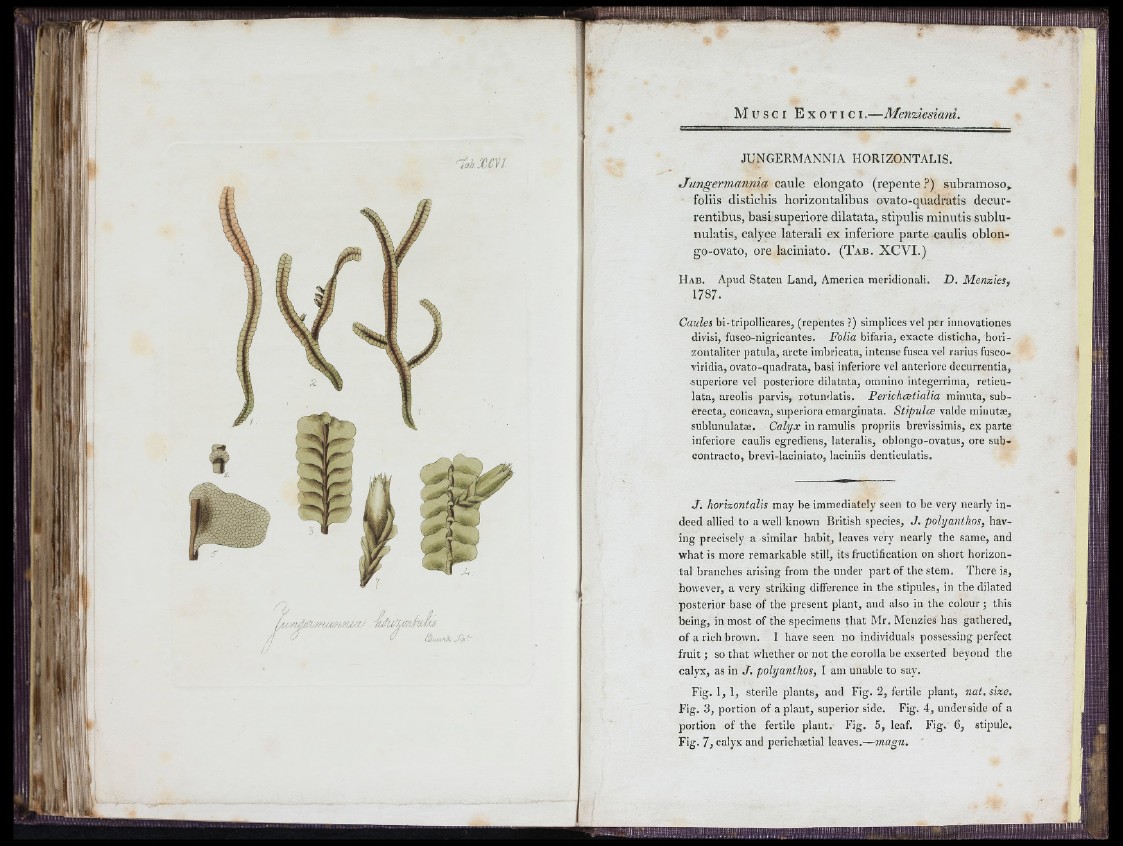
k a hM V l
/ 'J
fnAfJijWM/oe’NÀ/v 'LkupfriJvJ/i/
j o Û Pj,y„tAj',L
JUNGERMANNIA HORIZONTALIS.
Jungermannia caule elongato (repente.'^) subramoso,,
foliis disticbis horizontalibus ovato-quadratis decurrentibus,
basi superiore dilatata, stipulis minutis sublu-
nulatis, calyce laterali ex inferiore parte caulis oblon-
go-ovato, ore laciniato. (T ab . XCVI.)
H ab. Apud Staten Land, America meridionali. D . Menzies,
1787.
Caules bi-tripollicares, (repentes ?) simplices vel per innovationes
divisi, fusco-nigricantes. Folia bifaria, exacte disticha, horizontaliter
patula, arcte imbricata, intense fusca vel rarius fusco-
viridia, ovato-quadrata, basi inferiore vel anteriore decurrentia,
superiore vel posteriore dilatata, omnino integerrima, reticulata,
areolis parvis, rotundatis. Perichcetialia minuta, suberecta,
concava, superiora emarginata. Stipuloe valde miuutæ,
sublunulatæ. CaZy* in ramulis propriis brevissimis, ex parte
inferiore caulis egrediens, lateralis, oblongo-ovatus, ore sub-
contracto, brevi-laciniato, laciniis denticulatis.
J . horizontalis may be Immediately seen to be very nearly indeed
allied to a well known British species, J . polyanlhos, having
precisely a similar habit, leaves very nearly the same, and
what is more remarkable still, its fructification on short horizontal
branches arising from the under part of the stem. There is,
however, a very striking difference in the stipules, in the dilated
posterior base of the present plant, and also in the colour ; this
being, in most of the specimens that Mr. Menzies has gathered,
of a rich brown. I have seen no individuals possessing perfect
fruit ; so that whether or not the corolla be exserted beyond the
calyx, as in J , polyanthos, I am unable to say.
Fig. 1, 1, sterile plants, and Fig. 2, fertile plant, nat, size.
Fig. 3, portion of a plant, superior side. Fig. 4, underside of a
portion of the fertile plant. Fig. 5, leaf. Fig. 6, stipule.
Fig. 7, calyx and perichaetial leaves.—magn.
IL u>